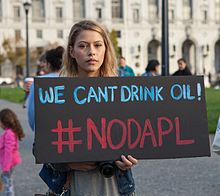Dakota Access Pipeline


The Dakota Access Pipeline ( DAPL for short ), also called Bakken Pipeline , is a largely completed oil pipeline in the USA with a length of 1,880 km. It runs from the oil-rich Bakken Formation in North Dakota through the US states of South Dakota and Iowa to the Patoka, Illinois pipeline junction .
Its construction is and was accompanied by protests beyond the USA and, after several judicial stops, was last put on hold in December 2016 by President Barack Obama until further notice. His successor in office, Donald Trump , called for the project to be completed and overturned the relevant decisions by decree . The opening of the pipeline took place on June 1, 2017, the lawsuits in federal courts continue.
Technical specifications
When completed, the pipeline will transport 75,000 m³ (470,000 barrels) of crude oil per day to Patoka , Illinois. From there, the oil can be transported via other pipelines to refineries on the Gulf of Mexico and the east coast of the USA.
Client
The initiator of the approximately 3.8 billion US dollar project is the pipeline operator Energy Transfer Partners . The project is funded by a number of banks, including JP Morgan Chase , Goldman Sachs , CitiBank , Morgan Stanley , BayernLB , Wells Fargo , BNP Paribas , SunTrust , Royal Bank of Scotland , Bank of Tokyo Mitsubishi , Mizuho Bank , TD Securities , ABN Amro Capital , Credit Agricole , Intesa Sanpaolo , Natixis , BBVA Securities , DNB First Bank , ICBC London , SMBC Nikko Securities , Societe Generale and Bank of America .
criticism
The US Army Corps of Engineers (USACE) approved the project in July 2016. Opponents of the pipeline are suing the construction plans in federal courts . Permission for the construction section in the Standing Rock Reservation was granted by the USACE, although the state agencies Environmental Protection Agency , the Department of the Interior and the Advisory Council on Historic Preservation pointed out that the USACE did not provide an adequate environmental impact statement ( Environmental Impact Statement ) took place. In particular with regard to the endangerment of the drinking water reserves, there was insufficient examination.
The Sioux Indians from the Standing Rock Reservation are suing the pipeline in several federal courts. They assert the violations of their guaranteed land rights. They also refer to the procedural errors in the environmental impact assessment. In March 2020, the federal district court ruled that the environmental impact assessment did not meet the legal requirements and obliged the US Army Corps of Engineers to carry out a completely new EIA.
In August 2017, Energy Transfer Partners filed a SLAPP lawsuit against Greenpeace , Earth First! , BankTrack and other protest organizations under the Racketeer Influenced and Corrupt Organizations Act, which is intended to combat mafia activities . The company blamed them for “billions of dollars” in damage and accused them of “criminal activities and misinformation campaigns”. Energy Transfer Partners is represented by the law firm Kasowitz, Benson, Torres & Friedman , which also works for the Trump Organization .
Shut down
On July 5, 2020, the United States District Court for the District of Columbia decided that the pipeline must be drained and temporarily shut down by August 5, 2020. According to the court ruling, an environmental impact assessment must first be carried out so that the pipeline can continue to operate.
Web links
Individual evidence
- ↑ Rachel Dicker: A Lot of People Aren't Fans of This Pipeline in North Dakota. In: US News & World Report . September 8, 2016, accessed September 12, 2016 .
- ↑ a b NYMag: The Dakota Access Pipeline Went Online Today , June 1, 2017
- ^ Dakota Access Pipeline. In: www.daplpipelinefacts.com. Retrieved September 15, 2016 .
- ↑ Demonstrators protest Dakota Access Pipeline in downtown Chicago. In: WGN-TV. September 9, 2016, accessed September 12, 2016 .
- ↑ Company Overview. In: www.energytransfer.com. Retrieved September 9, 2016 .
- ↑ German banks earn money from building the pipeline. Retrieved September 10, 2016 .
- ↑ Who's Investing in the Dakota Access Pipeline? Meet the Banks Financing Attacks on Protesters. In: Democracy Now! Retrieved September 10, 2016 .
- ↑ Who's Banking on the Dakota Access Pipeline? In: littlesis.org. Retrieved September 10, 2016 .
- ^ Georgianne Nienaber Writer: DAPL Pipeline Interests Try Outrageous Fait Accompli and Destroy Ancient Sites. In: The Huffington Post . September 4, 2016. Retrieved September 9, 2016 .
- ^ New York Times: Standing Rock Sioux Tribe Wins a Victory in Dakota Access Pipeline Case , March 25, 2020
- ↑ National Public Radio : Dakota Access Pipeline Owner Sues Greenpeace For 'Criminal Activity' , August 22, 2017.
- ↑ Greenpeace : What You Need to Know About Energy Transfer Partners' lawsuit , June 3, 2018.
- ↑ Jacey Fortin, Lisa Friedman: The New York Times, Dakota Access Pipeline to Shut Down Pending Review, Federal Judge Rules The ruling, a victory for the Native American and environmentalist groups who oppose the pipeline, said that it must be emptied of oil by Aug. 5.
- ↑ Breaking News July 7, 2020 CKON Radio of the Akwesasne Mohawk Nation.

